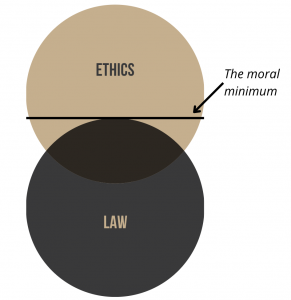Part 1: The Relationship of Legal and Ethical Duties
5 What is the idea of a “moral minimum”?
There are various definitions of the term “moral minimum” (Google it!), but for our purposes this means making an effort to comply with the law but going no further. This is represented in the Venn diagram below, which shows ethics above law with a dividing line. That line is the “moral minimum”.

The law does not correct (or claim to correct) every wrong that occurs in society. At a minimum, it aims to curb the worst kind of wrongs, the kinds of wrongs that violate the moral minimums that a community demands of its members. Ethical behavior will often go far beyond a moral minimum. For example, a business complying with the moral minimum versus its employees might make sure not to violate Title VII, the federal law prohibiting certain types of discrimination in the workplace (religion, national origin, race, color, or sex), but ignore discrimination based on non-protected attributes (such as body type or political preferences, or Star Wars versus Star Trek preferences). Discriminating in the workplace based on these attributes might be legal, complying with the moral minimum, but not ethical.

Exercises
- What are other examples of a company complying with the moral minimum, but no more?
- While we have not yet fully studied the benefits of ethical behavior, can you think of any benefits for going beyond the moral minimum? Would there be any corresponding costs?

